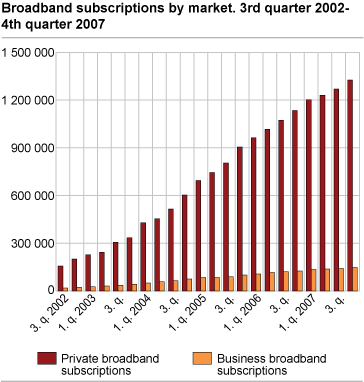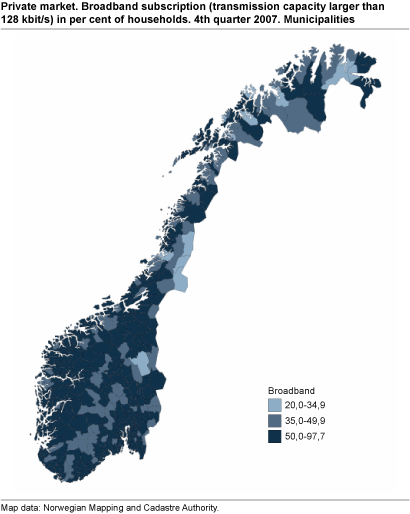Content
Published:
This is an archived release.
Positive effects of broadband investments
The number of broadband subscriptions was 1 473 000 at the end of the fourth quarter, an increase of 213 000 in the last twelve months.
At the end of the fourth quarter, Norway had 1 326 000 private broadband subscriptions, an increase of 17 per cent compared with the fourth quarter of 2006. In the same period, the number of business broadband subscriptions increased by 17 per cent to 147 000. Compared with the low increase during the second quarter of 2007, the increase was doubled in the fourth quarter. This indicates that the initiative to provide broadband nationwide seems to be giving the desired results.
The broadband penetration rate in private households is now 64.2 per cent. The number of private broadband subscriptions per 100 households varies between 70 per cent in the counties of Akershus and Rogaland and 54 per cent in Finnmark.
| Centrality1 | Broadband subscriptions |
Broadband subscriptions
in per cent of households |
|||||||||||||||||||||||||||||||||||||
|---|---|---|---|---|---|---|---|---|---|---|---|---|---|---|---|---|---|---|---|---|---|---|---|---|---|---|---|---|---|---|---|---|---|---|---|---|---|---|---|
| Remote municipalities | 139 966 | 54 | |||||||||||||||||||||||||||||||||||||
| Fairly remote municipalities | 85 139 | 60 | |||||||||||||||||||||||||||||||||||||
| Fairly central municipalities | 314 823 | 62 | |||||||||||||||||||||||||||||||||||||
| Central municipalities | 785 436 | 68 | |||||||||||||||||||||||||||||||||||||
| 1 | Standard Classification of Municipalities, 1994 (NOS C 192). |
The most central municipalities have the highest number of broadband subscriptions relative to the number of households (68 per cent), while this figure is 54 per cent in less central municipalities.
For the first time, no municipality has less than 20 private broadband subscriptions per 100 households and only 13 municipalities have between 20 and 35 private broadband subscriptions per 100 households.
|
A few small, but locally important Internet service providers, mostly cable-TV providers, are still not included in the survey. Efforts have been made to include these providers. Some small errors related to the distribution of subscribers between municipalities may occur. This may have strong effects on the figures per household for some municipalities. |
| Municipalities |
Broadband subscriptions
in per cent of households |
||||||||||||||||||||||||||||||||||||||
|---|---|---|---|---|---|---|---|---|---|---|---|---|---|---|---|---|---|---|---|---|---|---|---|---|---|---|---|---|---|---|---|---|---|---|---|---|---|---|---|
| $Average for all municipalities | 64.2 | ||||||||||||||||||||||||||||||||||||||
| 0941 Bykle | 93.2 | ||||||||||||||||||||||||||||||||||||||
| 1252 Modalen | 92.7 | ||||||||||||||||||||||||||||||||||||||
| 1121 Time | 85.0 | ||||||||||||||||||||||||||||||||||||||
| 0544 øystre Slidre | 83.4 | ||||||||||||||||||||||||||||||||||||||
| 1924 Målselv | 81.2 | ||||||||||||||||||||||||||||||||||||||
| 1563 Sunndal | 77.9 | ||||||||||||||||||||||||||||||||||||||
| 1221 Stord | 77.1 | ||||||||||||||||||||||||||||||||||||||
| 1714 Stjørdal | 76.4 | ||||||||||||||||||||||||||||||||||||||
| 0213 Ski | 75.5 | ||||||||||||||||||||||||||||||||||||||
| 1804 Bodø | 75.5 | ||||||||||||||||||||||||||||||||||||||
| 0706 Sandefjord | 75.3 | ||||||||||||||||||||||||||||||||||||||
| 1124 Sola | 75.1 | ||||||||||||||||||||||||||||||||||||||
| 0233 Nittedal | 75.1 | ||||||||||||||||||||||||||||||||||||||
| 0219 Bærum | 75.1 | ||||||||||||||||||||||||||||||||||||||
| 1122 Gjesdal | 74.4 | ||||||||||||||||||||||||||||||||||||||
| 0228 Rælingen | 74.3 | ||||||||||||||||||||||||||||||||||||||
| 1127 Randaberg | 74.0 | ||||||||||||||||||||||||||||||||||||||
| 1103 Stavanger | 73.4 | ||||||||||||||||||||||||||||||||||||||
| 1601 Trondheim | 73.4 | ||||||||||||||||||||||||||||||||||||||
| 0231 Skedsmo | 73.2 | ||||||||||||||||||||||||||||||||||||||
| 0235 Ullensaker | 72.8 | ||||||||||||||||||||||||||||||||||||||
| 0217 Oppegård | 72.5 | ||||||||||||||||||||||||||||||||||||||
|
Individuals and businesses may have several Internet subscriptions and several individuals may use the same subscription. The number of subscriptions is therefore not equivalent to the number of households/businesses with Internet access. A household can for instance get Internet access through an employer, educational institutions or by sharing access with other households. The survey ICT in households contains more information about households with at least one member under the age of 75 with Internet access. For more information, see About the statistics . |
Tables:
- Table 1 Private broadband subscriptions. Subscription by transmission capacity and county. 4th quarter of 2007
- Table 2 Business broadband subscriptions. Subscription by transmission capacity and county. 4th quarter of 2007
- Table 3 Development features. Broadband subscription by market. Active subscriptions only. The whole country
- Table 4 Broadband subscriptions (larger than 128 kbit/s). Business and private subscriptions. 4th quarter 2007. Municipality
Contact
-
Statistics Norway's Information Centre
E-mail: informasjon@ssb.no
tel.: (+47) 21 09 46 42


